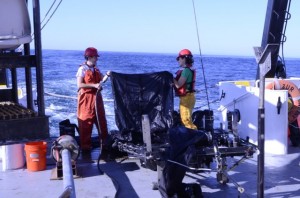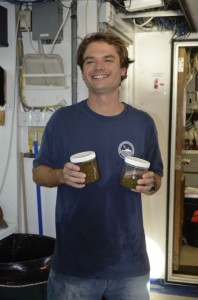by Ryan Rykaczewski
Nearly all of the food that nourishes ocean predators passes through zooplankton. These microscopic organisms are a critical link between the ocean’s primary producers (the phytoplankton) and the higher predators such as sharks, marine mammals, fish, seabirds, and turtles. Changes in the distribution of zooplankton in the ocean can impact the productivity of these higher trophic level organisms and influence the flow of carbon, nutrients, and energy through the marine ecosystem.
The survival of zooplankton in the ocean is dependent on a delicate balance of avoiding predators and finding food. Zooplankton find highest concentrations of their phytoplanktonic prey near the sunlit ocean surface. However, venturing into this upper part of the ocean water column exposes zooplankton to visual predators that are always on the lookout for a quick meal. In response to these contrasting pressures—the need to find food at the surface while also minimizing the likelihood of predation—zooplankton throughout the world’s oceans conduct a massive migration every dawn and dusk: typically rising towards the surface under the protection of darkness at dusk to find food and then descending to the dark ocean depths as the sun rises at dawn.
Mesoscale and submesoscale features (fronts, eddies, jets, and squirts) in ocean circulation are associated with vertical flow in the water column that create anomalies in food availability and predation risk for the ocean’s zooplankton. These anomalies act like loopholes in laws of ocean ecology and may supply zooplankton in the deep twilight zone with relatively nutritious, phytoplankton-rich waters. On the UNOLS Chief Scientist Training Cruise, I have been investigating how fronts formed by jets and squirts in the California Current affect the distribution of zooplankton and their interactions with their prey and predators. By using a plankton net known as the Multiple Opening/Closing Net and Environmental Sensing System (MOCNESS; or MOCNESS Monster by those who have grown familiar with its operation), I have been collecting zooplankton from various depths across submesoscale fronts. The MOCNESS comprises 10 nets that can be opened and closed in sequence. Although the MOCNESS Monster can be a handful to operate, it can provide valuable insight into the biological dynamics of ocean ecosystems. With the zooplankton samples collected with the MOCNESS, I intend to examine how composition and depth distribution of zooplankton are influenced by submesoscale circulation and shed some light on how these circulation features may influence predator-prey encounter rates in ocean ecosystems.


MOCNESS deployment. Amy and Amanda rinse down the 10 nets.

Ryan showing off his plankton samples.
Photo credits: (top left: Amy Wagner, top right: it’s a mystery, bottom: Amanda Netburn)
